Eternity Bands
Безконечники
Eternity Bands
Безконечники

Eternity bands and other dividing elements on pysanky are composed of meanders, waves, lines and ribbons. For more detailed information and examples of pysanky with these motifs, go to the corresponding pages in the Meander Gallery.
The meander, known in Ukrainian as a «безконечник» ("bezkonechnyk" or eternal line), is a line without a beginning or end. It is one of the oldest motifs found on Ukrainian artifacts – examples of the bezkonechnyk are commonly seen on pottery from the Trypillian period (ca. 5500-2750 BC), as on the pieces below:
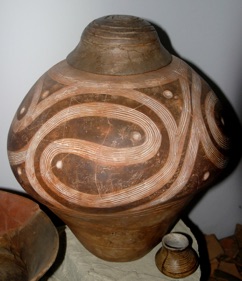

It is also one of the more common motifs on pysanky, for utilitarian as well as talismanic reasons. On the one hand, it can be used to divide the egg into sections, to separate one design from another. On the other, it has strong magical protective powers.
According to folk belief, the meander has a protective effect similar to that of a spiral. Since the meander on a pysanka has no beginning and no end, an evil spirit which happens to enter a house and lands on the egg is trapped forever, and will never bother the residents again.
The meander itself symbolizes harmony, motion, infinity and immortality. According to Selivachov, the principle element of the bezkonechnyk is a closed spiral, and “the endless line symbolizes the incessant movement of the sun and of time in general.” He notes that the spiral is sometimes stylized as a zig-zag, although usually in modalities other than the pysanka.
Meanders are common throughout Ukraine, but the style of the meander varies greatly from region to region. This drawing by Binyashevsky demonstrates the variation seen:
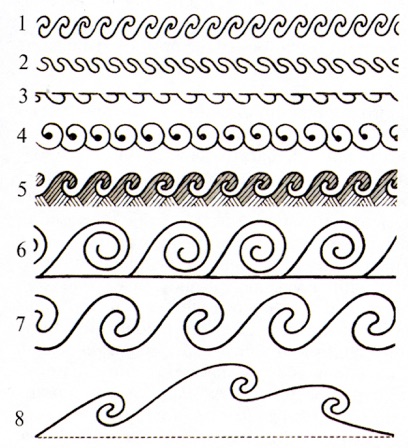
Binyashevsky: Elements of the Ukrainian meander on pysanky
1, 2, 3, 4: Hutsul regions of Ukraine
5: Northern Bukovyna
6: Transcarpathia/Zakarpattia
7: Volyn’
8: Kherson region (near the Black Sea)
Meanders tend to be smaller in western Ukraine, where they usually serve as a border for the main design, and get larger in parts of central and eastern Ukraine, often encompassing the entire pysanka and becoming the main design element.
In the western areas, particularly among the Hutsuls, meanders are small and delicate, and are used as a decorative border between other elements of the pysanka, as in these examples:


Selivachov uses the following traditional pysanky as examples of the bezkonechnyk more common to “Velyka Ukraina” (Greater Ukraine, or central and eastern regions):
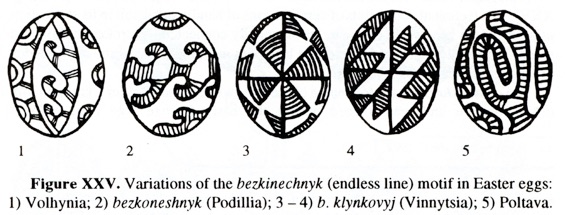
Selivachov’s examples 1, 2 and 5 are obvious meanders; 3 and 4 are a more zig-zagged (and less fluid) version. All are examples of the bezkonechnyk being the central motif, rather than just a decorative band. The pysanky directly below are similar in pattern to his first three examples.



Bezkonechnyk (Poltava region)
Binyashevsky provides several examples of bezkonechnyky in his work, including these two


Gypsy Roads (Циганські дороги), Eastern Podillia; Bezkonechnyk, Poltava region
In some parts of Ukraine, particularly in those regions near the sea, meanders are referred to as waves. The pysanka below, «Хвилі» (“Waves”), is from the Odessa region, near the Black Sea.
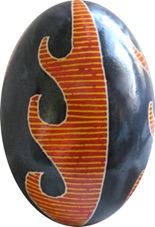
Whether this is a later renaming of the bezkonechnyk, or a parallel evolution of the motif, is not known. What is known is that zigzags or wavy lines were also water symbols, as they were depictions of the serpent, the god of water. (See the zoomorphic symbolism section for more information.)
Curved, zig-zagging and wavy lines can represent the serpent and water, but they can also be simply «кривульки» (“kryvul’ky”), or crooked lines.




Examples of kryvul’ky (zig-zag type) found on pysanky include these traditional patterns from Volyn’:


Or on this Lemko pysanka:

Kryvul’ky also have great antiquity, also being found frequently on Trypillian pottery:
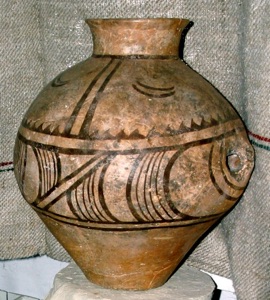

“Crooked” does not necessarily have a negative connotation here (i.e. the antithesis of “straight” or good), and is generally merely physically descriptive. However, as Selivachov notes, “In the casting of spells, when help is sought from evil forces, contrasts often figure: I will dry myself with an unwoven and unspun horse’s tail, I will leave not by the gate, but by the dog’s trapdoor, I will go not by roads, but by cockroach paths, etc.” (One can consider the traditional pysanka motif “Gypsy roads” in this light, based as it is on a zig-zag.)
Manko also notes that the kryvul’ka is reminiscent of the “crooked dance” (кривий танець, “kryvyi tanets”) in Ukrainian folklore, a «гагілка» (“hahilka” or ritual spring dance) which accompanies the «гаївка» (“haivka” or ritual spring song) – «Ми кривого танцю йдемо.......» (we move in a crooked dance.....)

Ми Кривого Танцю йдемо,
Ми в нім кінця не знайдемо.
Ані Кінця, ані ладу,
Не пізнати котра з заду,
То в гору, то в долину,
То в рожу, то в калину.
Our winding dance goes round and round,
No one can tell where the end is bound.
Can't see the end, not a straight line,
No one can tell who's the last in line.
Up the hight hill and down the vale,
Into the rose bush and kalyna we trail.
–(trans. Luba Wolonetz)
The “crooked dance” is performed in a circular (as in illustration above) or, more commonly, a winding, snake-like manner, often around three trees, three stakes, or three boys. This sinuous movement is meant to imitate the rolling movement of the sun, its rising and its setting. This ancient, pre-Christian dance was performed for hours on Easter Sunday, by both maidens and matrons alike.
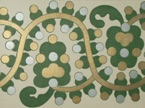
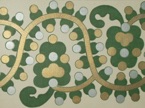
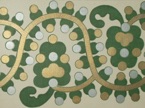
Ukrainian embroidery, XVIII century
Back to MAIN Symbolism home page.
Back to MAIN Pysanka home page.
Back to Pysanka Index.
Search my site with Google
